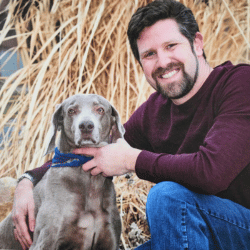Our canine companions are known for their habit of snuggling up with us. Sharing our bed with our dog has been shown to reduce our stress and anxiety, so naturally, we’d be concerned and confused when they decide to choose a different sleeping spot.
We discussed this question with two of Not A Bully’s advising veterinarians, Dr. Menicucci and Dr. Patel, and here’s what we came up with:
It can be difficult to pin down the exact reason why dogs change their usual routine and stop sleeping in bed, but it usually revolves around some specific change in the household routine, especially your sleeping routine.
However, these changes can be subtle and often not so obvious to us. Other changes, like shifts in temperatures, increased anxiety or stress, acute or ongoing health issues, and normal aging can all be responsible as well.
We’ll take a closer look at each explanation and help you figure out which reason makes the most sense for your pup. We’ll also help you understand how you can get you pup back in bed!
1. Household and Lifestyle Changes
Dogs are creatures of habit and are deeply attuned to their surroundings and the routines of their family members. Even small changes in the household, like rearranging furniture or coming home at a different time, can disrupt a dog’s sense of security and comfort, leading them to seek a different sleeping spot.
Of course, there are more obvious changes too like the arrival of a new pet, a new baby, or even a new partner. Children arguing with parents, household members staying up later than usual, more noises around the house, changing your dog’s feeding schedule and a long list of other household shifts can all cause your pup to switch sleeping spots.
What makes this difficult, is that even if these changes don’t make logical sense to us, they can still explain your dog’s behavior change. For example, coming home at a later time could lead dogs to seek a sleeping spot where they feel more secure or comfortable, perhaps in a quieter part of the house, as they may associate your delayed return with a disruption in their usual security and routine.
One UK study, while not directly tied to canine sleeping locations, looked at separation-related behaviors (like anxiety, stress, and destructive behavior) before and after the pandemic lockdown in 2020. The study found that 9.9% of dogs developed new separation-related behaviors following the easing of lockdown restrictions, which highlights the impact that changes in routine can have on our dog’s mental health.
In one dog training client that I worked with, we found that when she switched from using the garage to enter the house to using the front door her dog started sleeping by the front door. As confusing as it sounds, adding a home gym and parking on the street, through a cascade of reactions, led to her dog sleeping outside her bed. Her dog eventually went back to the bed after working on some stress reduction for her pup but it goes to illustrate how complicated this can be!
So take your time assessing any change that may have occurred in your home, even the small ones. Remember, you have a logical explanation for these changes but your dog doesn’t.
Once you understand what changed, you can either shift things back or support your dog through the specific change with consistency in the new routine and gradual acclimation techniques. If you’re not sure how to do that, you can always ask one of our dog trainers directly and share your specific situation.
2. You’re Tossing and Turning At Night
We’ve already covered changes in your routine like late nights or adding a new person to the bed but a more subtle change you may not be aware of is how you sleep- and the impact of stress on your sleep.
Tossing and turning in your sleep can be quite disruptive to dogs, especially if things are already a little tight in your bed. If you’re stressed, you may be tossing and turning more than usual without really noticing it. Studies from Oxford and others have shown that increased stress during the day leads to more tossing, turning, and twisting at night. Other studies have found that caffeine can cause some folks to have restless sleep with lots of tossing and turning.
Regardless of the cause, your dog doesn’t want to get bonked on the head at night! So naturally, they decide to choose another spot to rest.
You may find your dog sleeping closer to your head, where they’re less likely to catch a flying arm before they decide to leave your bed altogether. However, I’ve seen that most often in dogs 20 pounds or under, and larger dogs typically just look for a new spot to lay.
In this case, improving your own sleep could not only improve your dog’s rest but also bring them back to your bed. Of course, you could also try a bigger bed with more room to flip and flop! In some cases, it might not be your fault and if you have a dog like this then the biggest best still isn’t enough:
3. Temperature (Usually Your Dog Is Too Hot)
Typically, dogs prefer a cooler environment for sleeping, especially breeds with thick coats or larger body sizes and unless your dog is a chihuahua, whippet, or similar-sized dog, they’re likely too hot more often than they’re too cold.
Additionally, Dr. Nita Patel explains that “Normal body temperature for a dog can be anywhere from 99-103 at the highest.” This higher baseline means they might start to feel uncomfortable in temperatures that we find just right or even slightly cool.
While changes to the thermostat may be obvious to you, other changes aren’t so obvious. I’ve seen dozens of threads online and had conversations with pet parents over the years who have had their dogs stop sleeping with them after they became pregnant. While pregnancy is a big change, pregnant women run hotter which means their bed could become too toasty for a hot dog! Remember that subtly is key when figuring out our dog’s behavior!
You might find that during warmer seasons or if your room tends to be on the warmer side, your dog may opt for a cooler spot on the floor or in another room. It’s not uncommon for dogs to seek out tile or hardwood floors that stay cooler than a soft, warm bed. On the flip side, if your home is too cold, they might seek a warmer spot, perhaps curled up in a cozy corner away from drafts.
If you’re observing your dog avoiding the bed, check if they’re seeking out places that are significantly cooler or warmer than your bed. Are they lying on cool tiles, near air vents, or in the path of a fan? Or maybe they’re snuggled in a pile of blankets away from windows or doors. These choices can be strong indicators that temperature is a driving factor in their sleeping location preferences.
4. Anxiety and Stress
Situations like thunderstorms, not getting enough exercise, or feeling the need to guard can make your dog too restless or anxious to settle down comfortably in your bed.
While changes to your household aren’t guaranteed to have observable changes to your dog’s body language (remember the client that changed how they entered the home), if more severe anxiety or stress is the cause, you’re more likely to see other behavior besides just the change in sleeping location.
A stressed or anxious dog might pant excessively, pace around, show signs of restlessness, or even become more vocal. These behaviors stand out from the more relaxed, calm demeanor you’d expect at bedtime.
Addressing anxiety and stress in dogs often involves creating a calm environment, regular exercise, and sometimes behavior modification techniques like desensitization or counter-conditioning. If your dog’s anxiety seems severe, consulting a professional for tailored advice is always a wise step and you can start by asking one of our professional dog trainers. And you can work with us directly if you’re in Colorado Springs or the nearby areas.
Remember, a relaxed dog is more likely to return to their favorite spot in your bed, right beside you.
5. Age-Related Changes
As dogs grow older, their needs and preferences can change, much like they do in humans. It’s quite likely for an aging or senior dog to alter their sleeping habits due to various age-related factors- whether that’s a change in preference or mobility.
Older dogs often experience joint pain or arthritis, making it harder for them to jump onto the bed. If you notice your dog hesitating before jumping or opting for more accessible, comfortable spots, this could be a sign.
According to the American Animal Hospital Association, 20% of adult dogs will experience joint pain in their lifetime. Other estimates put it even higher and suggest that up to 35% of adult dogs will suffer from joint issues. But one thing is clear: the likelihood of joint issues increases as dogs age. Achy joints can lead some dogs to choose sleeping spots that are less difficult to reach.
Another aspect is the need for more uninterrupted sleep and studies have confirmed that older dogs need more sleep. A once cozy cuddle spot might now be too disruptive for their longer sleep cycles.
You might also observe a change in their sensory abilities. Aging dogs can have diminished hearing and eyesight, which could make them more inclined to sleep in a spot where they feel more secure and less vulnerable, possibly away from the openness of your bed.
Dr. Nita Patel adds that “While it is difficult to officially diagnose, cognitive dysfunction in dogs can occur as they age and can also lead to restlessness, difficulty sleeping at night, and changes to the regulation of day and night cycles, similar to humans with Alzheimer’s disease or dementia.”
The key difference between age-related changes and other reasons lies in the gradual nature of these changes. Unlike a sudden shift due to anxiety or environmental changes, age-related changes in sleeping habits typically occur more gradually.
Understanding these changes can help you make your aging dog more comfortable. Providing them with a comfy dog bed on the floor near you, or using dog stairs or ramps to help them onto the bed, can accommodate their changing needs while keeping them close.
6. Acute Health Issues
Unlike age-related issues or behavioral changes, acute health problems arise quickly and can significantly affect your dog’s comfort and behavior.
When a dog is in pain or discomfort due to an acute illness like an infection, injury, or stomach upset, they may seek solitude or a place where they feel more secure. This shift in sleeping location can be their way of coping with discomfort or pain.
Signs that might suggest an acute health condition include whimpering, limping, loss of appetite, unusual lethargy, or a sudden reluctance to engage in activities they usually enjoy. Also, watch for any changes in their bathroom habits or physical appearance, such as swelling or redness. These symptoms, especially when they appear suddenly, can differentiate acute health issues from other causes of sleep behavior change.
Simply put, if an acute health problem is the cause of your dog’s change in sleeping location you should expect to see other changes as well. However, remember that dogs often hide their pain, so subtle changes can be significant.
If you suspect your dog might be suffering from an acute health issue, it’s always a good idea to consult your veterinarian.
How To Encourage Your Dog To Sleep With You
Before implementing any training strategies, make sure you’ve ruled out medical issues. Assuming your dog is healthy, we’ll break down a simple approach to reducing your dog’s stress and encouraging them to share your bed again.
Create a Positive Association With Your Bed
Begin by making your bed an inviting space for your dog.
Use positive reinforcement by rewarding them with treats, affection, or their favorite toys whenever they join you on the bed. This method builds a strong, positive connection between your dog and the bed. If your dog is hesitant to get on bed, try rewarding them just for entering the bedroom and patiently lead them to the bed. This technique is called shaping.
Comfort is Key
Ensure the bed is comfortable for your dog, especially when it comes to temperature. That could mean removing extra blankets, changing the thermostat, or giving them the side closest to the window.
But it’s not just about comfort in the bed, but keeping things comfortable getting into and out of the bed. For senior or smaller dogs who may have difficulty jumping up, provide a ramp or steps to make it easier for them to get onto the bed. In many cases, getting down can be just as perilous so use positive reinforcement techniques to encourage dogs to use stairs or ramps on way down too.
Establishing a Stress-Free Routine
We’ve already established how important it is to keep things consistent so try to invite your dog onto the bed at the same time each night to establish a regular routine. You’ll also want to do the same things before bed and your dog will pick up on the signs that it’s almost time to jump in bed.
Patience, Consistency, and Reinforcement
Changing behavior takes time and patience. Continue to reinforce the desired behavior of sleeping on the bed consistently, and over time, your dog is likely to adapt to this new routine. Even after you have your routine, consider occasionally offering a high-value reward (usually a treat) when your pup gets into bed. This technique is called intermittent reinforcement and can help keep the behavior strong and consistent.
Closing Thoughts
In the ever-evolving relationship with our furry companions, every change is an opportunity to strengthen our bond.
By tuning into their needs and subtle changes in our house, making adjustments, and using positive reinforcement techniques, we can get our pups back to our bed! If you have any issues or feel there’s something we haven’t covered, feel free to reach out or drop a comment below and we’ll be happy to help!



